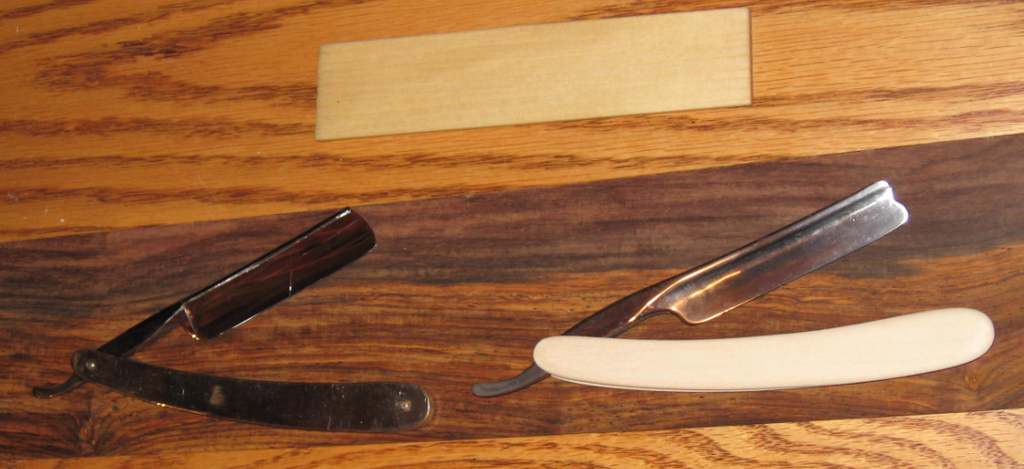Results 11 to 20 of 26
Thread: CA vs. Tung Oil (?)
-
02-01-2008, 04:59 AM #11Senior Member

- Join Date
- Jan 2008
- Posts
- 396
Thanked: 4
I'm not much of a picture taker but here where I got to tonight.

-
02-01-2008, 05:08 AM #12

What about epoxy-resin finish for wood scales? Worked good on my kitchen table, dries clear, hard, water resistant.
-
02-01-2008, 05:20 AM #13
-
02-07-2008, 04:03 AM #14

CA : cryanoacrylate (glue), AKA "super glue" "Krazy Glue" etc.
Tung Oil: various brands use widely different formulations and still call their formulation 'tung oil'. Most are a combination of oil and resin in various amounts. Very similar to (sometimes exactly) a thinned varnish.
Tung Oil issues: Tung oil is easier to apply but takes time to dry between coats to build fully protective coat. Anywhere from 4-6 coats typically applied with roughly a week of drying time per coat. Unlike CA, TO will wear off and will eventually need reapplication. On the other hand, CA is sticks to everything, the fumes are noxious, it's expensive and it dries too quickly. It can be thinned/removed with acetone when wet, so I'd keep a bottle on hand.
If I had to choose between the two I would probably go with either CA or varnish and skip the tung oil. If I went with a varnish I'd go with a quick dry (Sherwin Williams) and would thin 1:1 with Naptha, but that's my preference. The best recommendation I can make is test a small bit of both on some scrap pieces from your project. You'll never really know what you're working with and how well it might work for you until you take that step.
Sincerely,
Chris
-
02-07-2008, 07:01 AM #15

I like that response Chris, thanks.
-
02-07-2008, 01:59 PM #16Member

- Join Date
- Jan 2008
- Location
- Australia
- Posts
- 78
Thanked: 2
I have to say that I think pure Tung Oil is an excellent product but I would never, ever buy TO that has added hardeners etc. Pure TO will keep indefinitely, the less air exposure the longer the life span. So always decant into a smaller container as it dwindles.
I am a tool collector & use TO on any wooden part ~ First coat ~ always generous, apply with a soft cloth, let it soak in & then remove the excess. 24 hrs later a light coat ~ any excess can be wiped off. I've never had a problem with too much oil or with drying time affecting the finish ~ and TO can be reapplied anytime you like.
.....momma
PS I have read posts about making scales from wood, ivory, bone etc If you ever try to make scales from shell be very careful as the dust is extremely toxic .
-
02-07-2008, 02:19 PM #17
-
02-08-2008, 04:49 PM #18

Wood dust from sanding or turning can be very toxic. Here is a link to a toxicity chart from the Greater Vancouver Woodturners. It breaks down toxicity by type and wood. It is best to wear a mask when sanding. My Dad turned me several sets of handles for my espresso machine using Cocobolo (which happens to be very toxic) and ended up with a chest cold/infection that took months to get rid of. I machine sand my scales on a large belt/disk sander and final sand by hand. I wear a mask during both operations.
-
02-08-2008, 08:04 PM #19

Dave, what kind of mask do you use? A regular white dust mask or a more elaborate mask with filters?
Just want to know before I start on those kinds of woods and end up with an infection!
Mark
-
02-09-2008, 03:56 AM #20

I use those white throw away masks. Sanding with any kind of power sander creates a lot of dust. I have thought about getting a better mask, but can't justify it for the low output that I produce in terms of scale production. I also however have a shop vac which I hook up to my various power tools. With my belt sander it works wonders... literally no dust anywhere outside of the vac itself! So sometimes I don't even use a mask, although lately I have thought about it in concern for safety more and used one. I even hold the shop vac tube sometimes while sanding with the dremel. It takes a lot of that wood dust out of the air. Sorry we're getting a little off topic.


 LinkBack URL
LinkBack URL About LinkBacks
About LinkBacks









